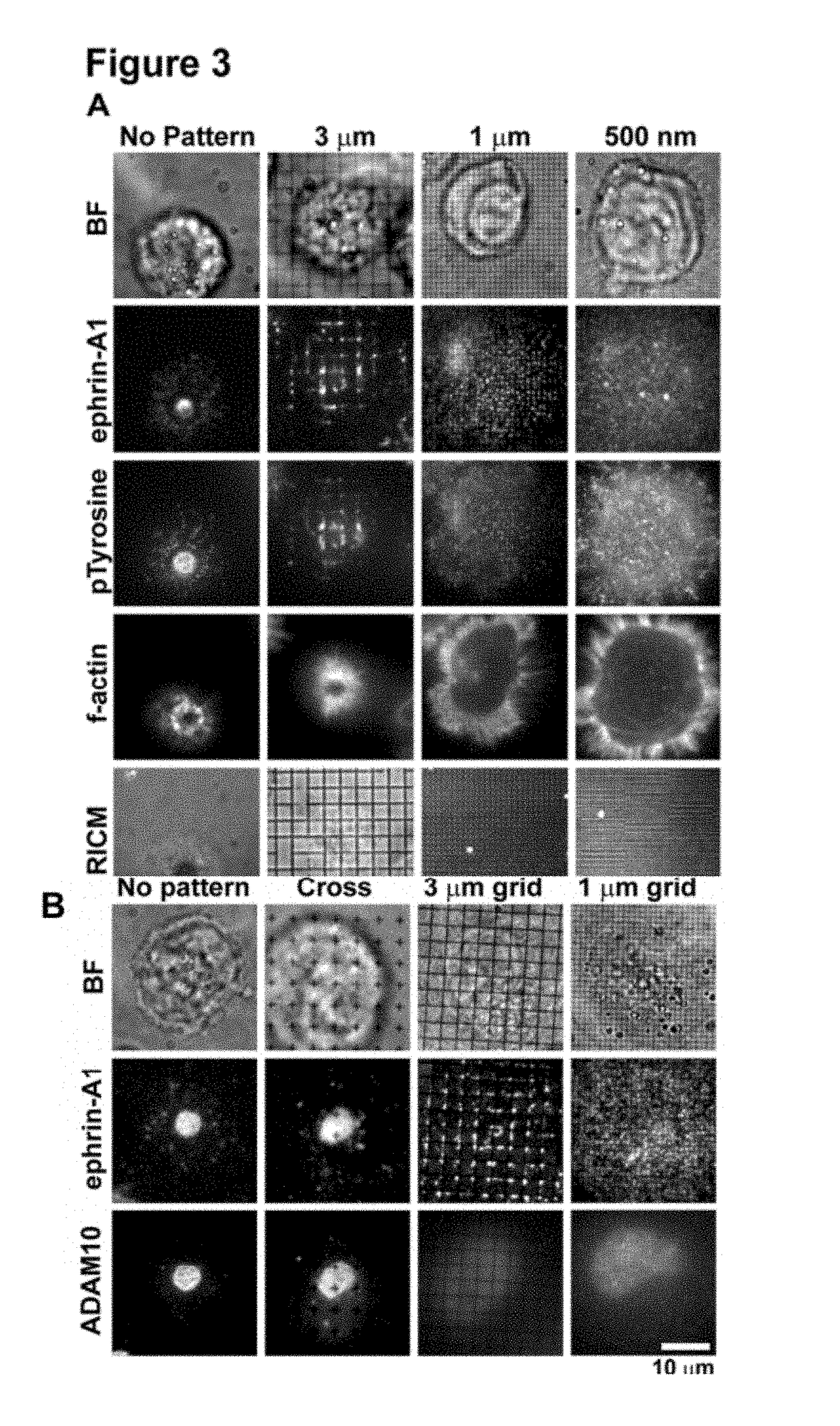Spatial biomarker of disease and detection of spatial organization of cellular receptors
a cellular receptor and disease biomarker technology, applied in the field of live cell assays, can solve the problems of deconstructing the function of cell-surface signaling molecules, unable to elucidate in vivo receptor function and behavior, and more complicated conditions of diseased tissu
- Summary
- Abstract
- Description
- Claims
- Application Information
AI Technical Summary
Benefits of technology
Problems solved by technology
Method used
Image
Examples
example 1
[0121]Many aspects of cancer result from aberrant signal transduction at the cell surface. Metastasis is one of the most deadly processes of cancer, and each of its phases (detachment, migration, invasion, growth, and survival) is regulated by cell-cell contact interactions and the associated signaling systems. For example, recent studies have found the EphA2 receptor tyrosine kinase (RTK) to be frequently over expressed and functionally altered in aggressive tumor cells (40% of breast cancers [B. L. Jackson, J. T. Groves, J. Am. Chem. Soc. 126, 13878 (2004)]), and that these changes promote metastatic character (FIG. 2A) [M. M. Davis et al., Annu. Rev. Biochem. 72, 717 (2003)]. EphA2 is one of the Eph receptors, which constitute the largest family of RTKs in the human genome and, together with their membrane-bound ephrin ligands, regulate a broad range of signaling processes at intercellular junctions. In addition to metastasis, Eph receptors are involved in oncogenic transformatio...
example 2
[0153]Activation of the EphA2 receptor tyrosine kinase by ephrin-A1 ligands presented on apposed cell surfaces plays important roles in development and exhibits poorly understood functional alterations in cancer. Here, we reconstitute this intermembrane signaling geometry between live EphA2-expressing human breast cancer cells and supported membranes displaying laterally mobile ephrin-A1. Receptor-ligand binding, clustering, and subsequent lateral transport within this junction are observed. EphA2 transport can be blocked by physical barriers nanofabricated onto the underlying substrate. This physical reorganization of EphA2 alters the cellular response to ephrin-A1, as observed by changes in cytoskeleton morphology and recruitment of the protease ADAM10. Quantitative analysis of receptor-ligand spatial organization across a library of 26 mammary epithelial cell lines reveals characteristic differences that strongly correlate with invasion potential. These observations reveal a mech...
example 3
[0158]The fluidity of the membrane is critical for observing CAD formation, and fully saturated 1,2-dipalmitoyl-sn-glycero-3-phosphocholine (DPPC) lipids that are non-fluid at 37° C. do not allow the coalescence of microclusters and their subsequent transport into the CAD (FIG. 2E).
[0159]To evaluate how the supported membrane affects EphA2 activation, we measured the degradation of EphA2, which is a direct consequence of ligand-induced receptor stimulation. Western blots measuring EphA2 degradation (FIG. 2D), indicate that membrane-bound ephrin-A1 activates EphA2 to the same degree as soluble ligand stimulation (1 ng / ml). However, ephrin-A1 anchored to non-fluid DPPC membranes can only activate EphA2 to ˜50% of the maximum achieved with fluid membranes (FIG. 2D). These results clearly indicate that the activity of chemically identical ligands can be modulated by altering membrane fluidity, thus suggesting an additional level of finely tuned responses in Eph-ephrin signaling.
[0160]Th...
PUM
| Property | Measurement | Unit |
|---|---|---|
| mass | aaaaa | aaaaa |
| height | aaaaa | aaaaa |
| height | aaaaa | aaaaa |
Abstract
Description
Claims
Application Information
 Login to View More
Login to View More - R&D
- Intellectual Property
- Life Sciences
- Materials
- Tech Scout
- Unparalleled Data Quality
- Higher Quality Content
- 60% Fewer Hallucinations
Browse by: Latest US Patents, China's latest patents, Technical Efficacy Thesaurus, Application Domain, Technology Topic, Popular Technical Reports.
© 2025 PatSnap. All rights reserved.Legal|Privacy policy|Modern Slavery Act Transparency Statement|Sitemap|About US| Contact US: help@patsnap.com



